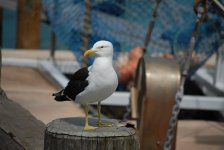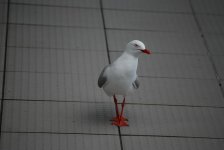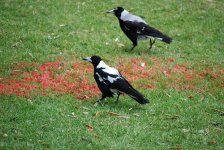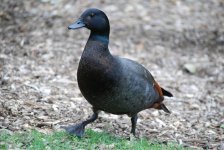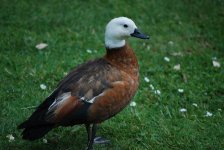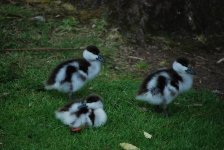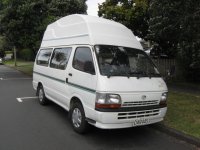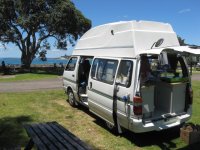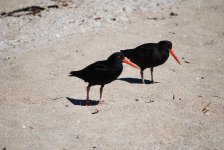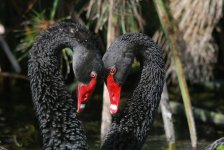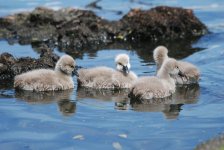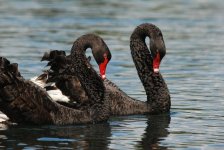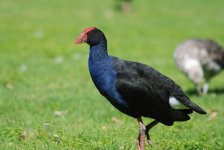Maroon Jay
Airborne

Hello everyone. I have arrived in New Zealand for a tour of the country and of course its birds. I am in Auckland and have seen 12 birds so far without leaving the city.
The best location so far was the Auckland Domain which is a large park. The Auckland Museum is in this park and is well worth visiting. The first floor of the museum is devoted to culture of the native Maori and the early European settlers. The second floor contains a huge display of NZ natural history which includes stuffed birds and other critters and information about volcanos, etc. They have bones and a reconstruction of the extinct Moa which is something like an ostrich. They existed in several sizes, the largest being about the size of a giraffe. Great exhibit. I also saw a stuffed Albatross. What a huge bird. Like a gull the size of a turkey. Can't wait to see a live one. They also have some stuffed kiwis and other birds. It is a good way to learn about birds that you hope to find in the wind and also view some now extinct ones. The top floor of the museum is devoted to miliary history which I also found interesting.
Of the 12 birds that I saw, only three were New Zealand birds. All the others being introduced from other countries. These were the Paradise Shelduck, the Red-billed Gull, and the Kelp Gull. The imported birds were Mallard, Rock Pegion, Eastern Rosella, Australasian Magpie, Common Starling, Common Myna, Common Blackbird, Song Thrush, and House Sparrow.. The gulls were found at the harbour and all the others at the Auckland Domain.
I learned straight away that the names of the birds in NZ do not always correspond with the names on the IOU checklist or what the birds are called in North America or Europe. The Kelp Gull is called the Southern Black-backed Gull in NZ, the Australasian Magpie is called the Australian Magpie, the Common Myna is called the Indian Myna, the Common Blackbird is called simply Blackbird. I got into the habit of checking the scientific names to see if the bird has some other name besides the one it is known by in NZ.
The Australasian Magpie comes in two forms, with a white back and a black back. I saw only the white-back type. One the white-back form, the male is much whiter than the female which acutally looks grey as you can see in the photo.
I bought a camper van and it will be a week or so before I venture out to more interesting places.
The best location so far was the Auckland Domain which is a large park. The Auckland Museum is in this park and is well worth visiting. The first floor of the museum is devoted to culture of the native Maori and the early European settlers. The second floor contains a huge display of NZ natural history which includes stuffed birds and other critters and information about volcanos, etc. They have bones and a reconstruction of the extinct Moa which is something like an ostrich. They existed in several sizes, the largest being about the size of a giraffe. Great exhibit. I also saw a stuffed Albatross. What a huge bird. Like a gull the size of a turkey. Can't wait to see a live one. They also have some stuffed kiwis and other birds. It is a good way to learn about birds that you hope to find in the wind and also view some now extinct ones. The top floor of the museum is devoted to miliary history which I also found interesting.
Of the 12 birds that I saw, only three were New Zealand birds. All the others being introduced from other countries. These were the Paradise Shelduck, the Red-billed Gull, and the Kelp Gull. The imported birds were Mallard, Rock Pegion, Eastern Rosella, Australasian Magpie, Common Starling, Common Myna, Common Blackbird, Song Thrush, and House Sparrow.. The gulls were found at the harbour and all the others at the Auckland Domain.
I learned straight away that the names of the birds in NZ do not always correspond with the names on the IOU checklist or what the birds are called in North America or Europe. The Kelp Gull is called the Southern Black-backed Gull in NZ, the Australasian Magpie is called the Australian Magpie, the Common Myna is called the Indian Myna, the Common Blackbird is called simply Blackbird. I got into the habit of checking the scientific names to see if the bird has some other name besides the one it is known by in NZ.
The Australasian Magpie comes in two forms, with a white back and a black back. I saw only the white-back type. One the white-back form, the male is much whiter than the female which acutally looks grey as you can see in the photo.
I bought a camper van and it will be a week or so before I venture out to more interesting places.




